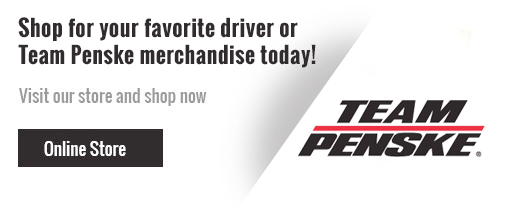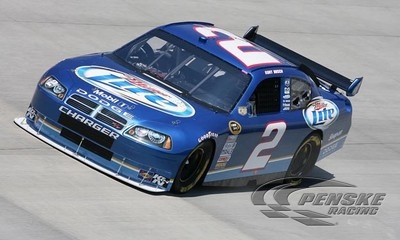Kurt Busch - NASCAR Cup Series Preview Dover
September 16, 2008
Sure, the record book shows that Wallace was the winner of the Sept. 19, 1993 Splitfire 500 on the one-mile, high-banked Dover track, but that fact has nothing to do with the reason that Busch says Wallace deserves such accolades.
"If Rusty hadn't done all the lobbying and politicking that he did back then, we could very well still be racing on an asphalt surface there this weekend," said Busch, the 2004 NASCAR Sprint Cup champion who took the driver's seat from Wallace in the Miller Lite-sponsored, Penske Racing-prepared No. 2 Dodge when he retired after the 2005 season. "I think everyone agrees now that the tracks with the high banking like at Dover and Bristol absolutely need concrete surfaces. But back then, the jury was out on that subject.
"I've always been a pretty big history buff of our sport," said Busch. "I know that Bristol had already gone to concrete, but it was all by itself. The story I've always heard was that you had Rusty leading the charge in campaigning for concrete at Dover and you had (Dale) Earnhardt Sr. being the guy most vocal in saying that the track should continue to use asphalt in their resurfacing projects.
"All the accounts that I have come across through the years indicate that Rusty's efforts back then sold the track management on going with the concrete instead of continuing to repave the track with fresh asphalt," said Busch. "It'd be really neat to read Rusty's version of what all went down back then."
Wallace, the 1989 series champ, a three-time Dover winner, 55-race winner overall and now a successful member of the ESPN-TV broadcasting team, was happy to oblige.
"We were having a great time back then, winning a ton of races, getting the sport's fan base really spiraling upward and helping get what we do plastered permanently on the map," said Wallace, as he paused from a busy schedule last weekend at New Hampshire Motor Speedway to recall the scenario he faced during the 1993-1994 seasons. "Dale and I were big rivals on the race track, but always close beer-drinking buddies off the track.
"I remember that Melvin Joseph was pretty much the man who carried the most clout around Dover back then," Wallace said of the late Joseph, the Georgetown, Del., contractor and developer who designed and built the Dover track and later was the Vice President and Director of Auto Racing at the facility. "Bristol had gone to concrete in 1992 and was going through sort of a transitional phase in its acceptance. I saw from the very first race there that it was the best way to go. It wasn't as heat-sensitive like asphalt and it stayed so much more consistent throughout the race.
"And for the track owners, it meant not having to go back and repave so often because the concrete didn't weather that much and would last for years without much maintenance," Wallace continued. "But there were still a few guys out there, especially Dale, who for some reason or another just didn't like concrete.
"I remember that Dale always would just throw that big grin of his at me and say, ‘Hey Rusty, you know that concrete is for driveways, not race tracks,'" Wallace said with a chuckle. "All I could do was shake my head, because I knew I wouldn't get anywhere arguing about it with him.
"So it came down to Dale and me hammering old Mel from every direction possible," Wallace continued with a mischievous smirk. "NASCAR let Melvin pull his coach into the garage area at Dover and park it right by their trailer. During those particular race weekends there starting with the spring
race of '93, I don't know how many times I saw Dale go in and out of the door of what became Mel's personal office in the garage area. I knew what he was doing - singing the praises of asphalt and doing what he could to get them to keep on using asphalt on the racing surface.
"I did the best I could to let my opinion of what should be done known, but I confess that I now think it was just a lucky coincidence that gave me the opportunity to drive my side of the deal home with Mel," said Wallace. "We had been doing several appearances for Miller at the Rusty Rudder (restaurant and bar) down in Dewey Beach and our group was down there again on the Thursday night before that fall race in '93.
"Our group was at one table and Mel and his group was at an adjoining table," Wallace continued. "We got to talking among the guys at our table about the problems they'd had with the
racing surface in the recent Dover races and I guess I was a little bit loud when I blared out that they oughta' just concrete the damned place.
"The next thing I knew, Mel yelled for me to come over there to his table and join him," Wallace said laughing. "I went over and pulled up a chair right in front of him, so we could be face-to-face. He said that he'd heard again just what I said and he wanted me to sell him on going with concrete. I presented my case in terms and language that must have made a big impression on Mel.
"It was like I had thrown a big John Wayne performance on him in that I'm convinced that Mel left the Rusty Rudder there that night won over that concrete was the best way to go and exactly what they were going to do," said Wallace. "I'm sure that Dale continued to hound him about it, even the next day at the track, but it didn't do any good.
"You know, I went on to win that September race in '93 and came back and won both of the races at Dover in 1994," Wallace concluded. "But even though I know that gave me quite a bit of credence, I'm convinced that it was that big, late-night rap session that Mel and I had there at the Rusty Rudder that night that turned the trick."
Busch is certainly appreciative of Wallace's efforts at Dover 15 years ago and remains amazed at the conditions he excelled under back then.
"I've seen the videos from the old battles that (Dale) Earnhardt Sr. and Rusty (Wallace) had there back during those years and it's pretty incredible," Busch said. "They were really going at it hard and heavy, the old pavement was chunking up in the turns and there was loose asphalt flying around all over the place. I remember Rusty even won a race where the conditions were like that and he was riding around out of fuel and with a flat tire. And just to think, they were having to get after it for 500 laps -- not 400 laps - back then. Those are legendary races that should be celebrated forever."
For the record, the original asphalt was laid in 1969 and resurfaced again in 1986. But as the years went by the asphalt became weathered and battered, causing several severe cracks and bumps to form. This led to the caution-filled races and upset drivers who were already having a rough enough time battling each other, let alone the racing surface.
So after months of deliberation and research - reinforced by the lobbying of Wallace - the Dover officials, led by Joseph, tackled the project of resurfacing the entire one-mile oval in concrete. Construction began immediately after the September 1994 race, and crews used more than 17 tons of cement, sand and stone, accumulating over $2 million in costs, to pour a smooth concrete surface that was unlike any other at the time. The main pouring of concrete took only five working days starting in November 1994, but preparation and final touches kept the crews busy all winter long.
NASCAR drivers, teams and fans returned to Dover for the June 4, 1995 Miller Genuine Draft 500 to find the bright new and extremely fast surface that brought new life to the 27-year-old race track. The welcomed chan

